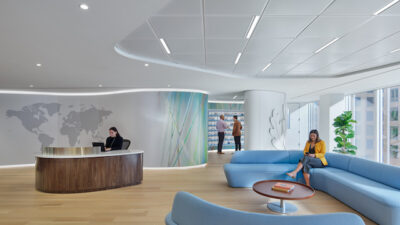A Chicago-based architectural engineering office integrated an Internet of Things (IoT)-based lighting control system.
When embarking on the design of its own new office space in Chicago in early 2015, SmithGroupJJR was faced with the unique challenge of designing the lighting and controls for three-quarters of the finished space while leaving roughly 3,000 sq ft to be completed in the future, but that would also be exposed to the rest of the “finished” office in the interim. The goal for the future space would be to accommodate staff growth with additional workstations, plus any support spaces determined to be needed.
At the start, a design team composed entirely of Chicago-based SmithGroupJJR architects, interior designers, and mechanical, electrical, and plumbing (MEP) engineers set out to rethink the entire concept behind their work environment. The results of extensive internal workplace-strategy sessions involving the entire staff pointed to a solution featuring an adaptable open studio and “free address” seating—one that would allow users to choose from an assortment of space and workstation types at will. The finished office is populated with reconfigurable furniture to suit a variety of work modes—the key to accommodating many disciplines. Ample daylighting and unobstructed views of the Chicago River and Loop life unfolding 9 floors below don’t hurt, either.
Adaptable lighting was central to this free address idea, enabling customization of light levels and effortless reorganization of space with the click of a mouse. But the project also posed challenges that restricted the lighting design. Open ceilings crowded with beams and extensive ductwork in a vintage building limited the choices for fixture and device types and their mounting locations, a tight budget called for calculated use of artistic and technological flourishes, and aggressive goals for energy reduction and monitoring—coupled with the requirement for rapid space reconfigurations and a future fit-out—complicated the lighting controls needs.
Taking into consideration the design for the future space, the limitations of the shell, and the firm’s sustainability ideals, the lighting designer worked with the rest of the team and local vendor support representatives to implement an Internet of Things (IoT)-based lighting control system for the first time. The final system is comprised of a dense array of Bluetooth-enabled sensors, both integrated and independent, that are distributed across the office to detect temperature, occupancy, and daylight at every point. Supported by minimal backbone equipment, the sensors and wall controllers transmit data wirelessly—the designers even got to walk the floor with the electrical contractor and point to the desired locations for the wall controllers after the drywall was finished and painted.
In the end, SmithGroupJJR’s Chicago employees are able to interact with the system through a floor-plan-based software program from any device with internet access, helping the office monitor energy usage, temperature, and trends, and allowing for reprogramming and reconfiguring of lighting as needed (which has been done on several occasions in response to user commentary since the October 2016 move-in). This responsibility is held by several among the staff, while the remaining occupants interact with the system primarily using their approximately 40 wall controllers.
Arguably the most attractive feature of the IoT for SmithGroupJJR, and the main reason the firm piloted the technology on its own office, was the system’s ability to map movement in the new space and to track use, illustrating how the office is actually used and helping to inform the future 3,000-sq-ft fit-out. To easily study this data, SmithGroupJJR also purchased an annual software subscription to analyze the usage data.
Equally attractive, every fixture in the space is dimmable and equipped with daylight and motion sensing. The lighting and control system beats the 2013 edition of ASHRAE Standard 90.1: Energy Standard for Buildings Except Low-Rise Residential Buildings lighting-power density requirements by 48% at a minimum. The final version of the programming limited most fixtures to a maximum of 80% of total output, pushing savings even further while prolonging fixture and driver life.
As a pilot project involving a new technology, SmithGroupJJR expected bumps along the road. And it encountered them. There was a learning curve, but the firm ultimately gained useful experience and knowledge to prepare for future IoT-based lighting control designs. Learning to think of a lighting layout in tandem with a sensor layout was the first step, as the sensors “wanted” to be spaced on a 10-ft grid for optimal system granularity.
Selecting fixtures that could integrate sensors as much as possible was next, along with devising a solution to mount stand-alone sensors where necessary, even though the sensors didn’t fit on a standard junction box. Then the team ran into confusion integrating the proper drivers and emergency controllers into some of the selected fixtures, even though they came from an OEM partner of the controls manufacturer (it all worked out in the end).
The final issues occurred after installation when a bad software update required numerous sensors to be replaced, and finally when a network-integration workaround had to be developed to avoid violating corporate information technology security requirements—the most difficult task that also drew the largest group of participants. In the end, the design team is happy with the results; they feel well-versed in the design approach required for this type of system and are poised to take on the task again.
Innovative lighting controls using IoT technology certainly helped SmithGroupJJR’s Chicago office achieve the goal of creating a new workplace that reflects their values. The end result is an atmosphere that fosters flexibility, interaction, and change, which suits their personality perfectly.
Katy C. Boat is an electrical engineer and lighting designer with SmithGroupJJR, concentrating on higher education, workplace, and health care projects with a sustainable focus.


